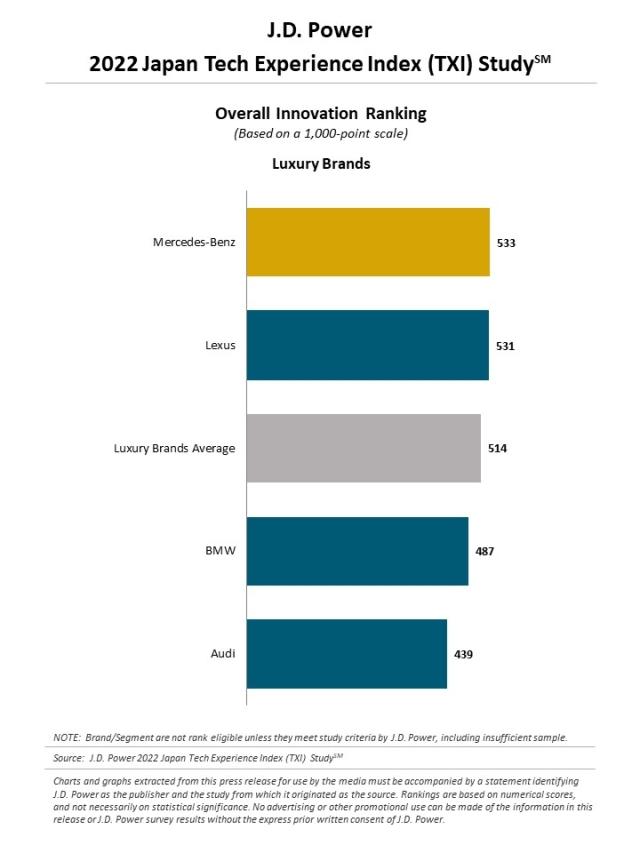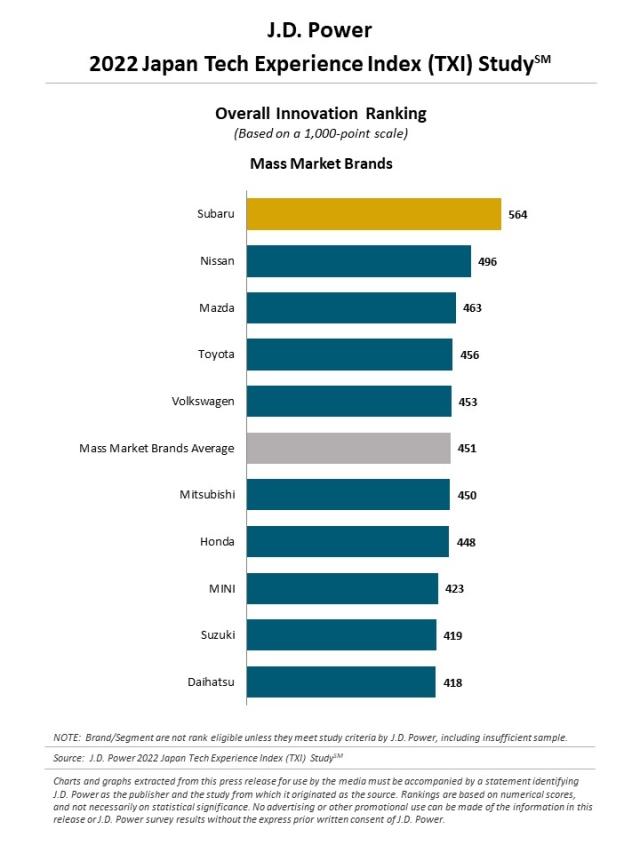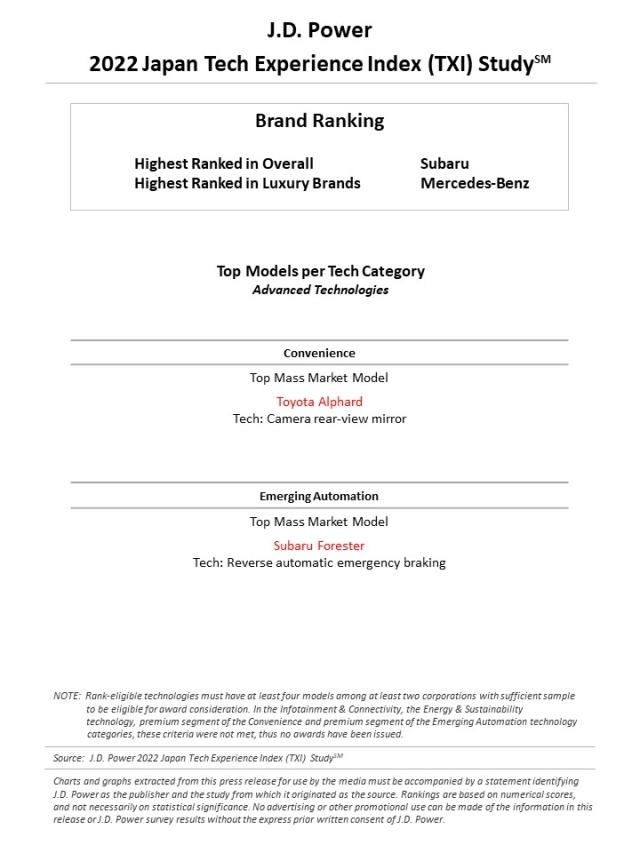Identifying and Implementing User Value of Advanced Technologies Crucial to Vehicle Development in Japan, J.D. Power Finds
Subaru Ranks Highest Overall for Tech Innovation for a Second Consecutive Year
TOKYO: 16 Nov. 2022 — Manufacturers must understand the user value of the advanced technologies installed in their vehicles as well as how users perceive their performance, and incorporate that data into future vehicle and technology development, according to the J.D. Power 2022 Japan Tech Experience Index (TXI) Study,SM released today.
“Installation, user evaluations and future installation intentions for the 201 advanced technologies included in the study vary depending on the technology,” said Yuji Sasaki, director of the research division at J.D. Power. “Some technologies receive interest from and are appreciated by users, which may lead to increased product appeal, but other technologies would not gain support from users unless they are radically improved or enhanced, such as interior gesture controls and phone-based digital keys. To develop the best possible vehicles with limited resources and assets, manufacturers need to establish a mechanism for quick decision-making to identify what users say about these technologies, select which technologies should be installed on new vehicles and determine which technologies should be enhanced.”
The study specifically focuses on the installation of features on new vehicles and owner usage and problems experienced with these features, as well as their intentions to recommend and repurchase, based on 31 features that include advanced technologies such as active driving assistance.
Following are key findings of the 2022 study:
- Luxury brands have more advanced technologies: On average, 1.9 new advanced technologies are installed in new vehicles. By vehicle segment, 1.4 are installed on mini-cars, 2.2 on mass market models (registered-car) and 3.3 on luxury models (registered-car). Among the 20 advanced technologies, drive recorder (69%), reverse automatic emergency braking system (44%) and active driving assistance system (35%) are more frequently installed on new vehicles, increasing by one to four percentage points from 2021. Users indicate higher levels of intent to install some or all of these technologies on their next new vehicle.
- Drive recorder is most often installed: Among the 20 advanced technologies, drive recorder is the technology most frequently installed on new vehicles (69%) and has the highest level of future intention to be installed (62%). This technology may be expected to become a standard feature in the future. However, because drive recorders are already common on new vehicles, user evaluations are relatively low (the Execution Index score2 is 778 points, on a 1,000-point scale) and thus this technology is unlikely to create a competitive differentiation. To make this technology into a strength, it will be necessary to drastically improve it based on users’ needs and usage.
1 The 20 advanced technologies are, in alphabetical order: active driving assistance system; active lane change assist system; augmented reality display; automatic emergency steering system; camera rear-view mirror; drive recorder; driver monitoring system; electric vehicle bidirectional charging system; electric vehicle energy assistant system; fingerprint reader; front cross traffic warning system; ground view camera system; interior gesture control; one pedal driving system; phone-based digital key; rear seat reminder system; remote parking assistance system; reverse automatic emergency braking system; safe exit assist system; and virtual assistant connectivity to vehicle technology.
2 The Execution Index score, on a 1,000-point scale, is calculated based on overall user evaluations (on a 10-point scale) and the total problems experienced with the advanced technologies.
- Satisfaction is higher among owners of vehicles with EV-related technologies: Due to the low acceptance of electric vehicles, advanced technologies installed on electrical vehicles, such as the one pedal driving system and electric vehicle bidirectional charging system, have low penetration rates in the entire market. However, users are highly satisfied with those technologies, particularly the one pedal driving system, which has the highest Execution Index score (850 points), and electric vehicle bidirectional charging system ( 826 points), the third highest score among the 20 advanced technologies. Also, for future intentions, 44% of users say they would install a one pedal driving system on their next new vehicle and 51% say they would install an electric vehicle bidirectional charging system.
- Interior gesture controls are most problematic: Among the 20 advanced technologies, interior gesture controls are the most problematic with a problems per 100 score (PP100) of 41.6 PP100, followed by phone-based digital keys (17.1 PP100). Future installation intentions are also low for these two technologies: 15% for interior gesture controls and 23% for phone-based digital keys. This suggests that it is essential to improve these technologies and for dealerships to educate users on their implementation.
- User support from dealer staff is imperative to promote the use of advanced technologies and improve user evaluations: Among the advanced technologies with a sufficient number of user evaluations, customers are more satisfied with the technologies when they receive explanations about the technologies from the dealer staff. This indicates that explanations by dealer staff and the education of customers would positively impact user evaluations. The largest gap in scores among customers who did receive explanations of advanced technologies and those who did not vary widely for two technologies: a 45-point difference for driver monitoring system (817 vs. 772 points, respectively), and a 43-point difference for active lane change assist system (836 vs. 793 points, respectively).
Highest-Ranking Brands
Subaru (564) ranks highest overall in the Innovation Index. Mercedes-Benz (533) ranks highest among luxury brands.
Advanced Technology Award Recipients
Toyota Alphard is the mass market model receiving the Convenience award, for camera rear-view mirror technology. For the luxury models in this technology category, no award has been issued this year because the ranking criteria were not met.
Subaru Forester is the mass market model receiving the Emerging Automation award, for reverse automatic emergency braking technology. For the luxury models in this technology category, no award has been issued this year because the ranking criteria were not met.
In the Infotainment & Connectivity and the Energy & Sustainability technology categories, no awards have been issued this year because the ranking criteria were not met.
The 2022 Japan Tech Experience Index (TXI) Study is based on responses from 20,797 purchasers of new vehicles in the first two to 13 months of ownership. The study was fielded from May through June 2022.
J.D. Power is a global leader in consumer insights, advisory services and data and analytics. A pioneer in the use of big data, artificial intelligence (AI) and algorithmic modeling capabilities to understand consumer behavior, J.D. Power has been delivering incisive industry intelligence on customer interactions with brands and products for more than 50 years. The world's leading businesses across major industries rely on J.D. Power to guide their customer-facing strategies.
J.D. Power has offices in North America, Europe and Asia Pacific. To learn more about the company’s business offerings, visit https://japan.jdpower.com/.
Media Relations Contacts
Kumi Kitami; Japan; 81-3-6809-2996; release@jdpa.com
Geno Effler; USA; 714-621-6224; media.relations@jdpa.com
About J.D. Power and Advertising/Promotional Rules www.jdpower.com/business/about-us/press-release-info


